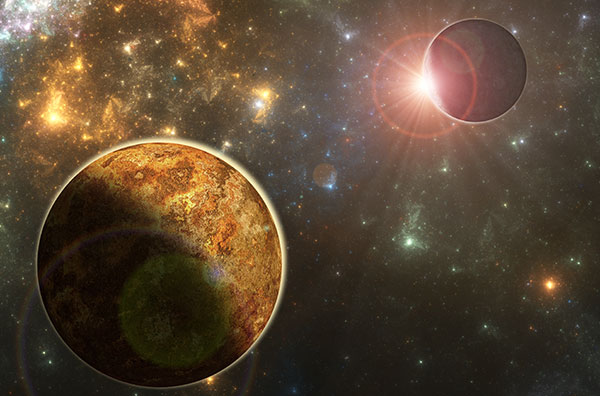
The story of Rahu and Ketu goes back to the tale of the samudra manthan or the churning of the celestial ocean, with devas on one side and the asuras on the other. Lots of treasures came out of the ocean and one of them was amrit, the elixir of immortality. Both the devas and asuras laid claim on it. Lord Vishnu took the form of Mohini, a divine beauty, and took upon the task of distributing amrit to the devas and asuras equally. A demon named Svarbhanu, sat amidst gods and consumed the elixir out of turn. Chandradevta (Moon god) and Suryadevta (Sun god) noticed him and they complained to Mohini. Enraged, Lord Vishnu, cut his head off but he could not die as he had already consumed the amrit. Svarbhanu’s severed head and body were thrown into space. Rahu is the severed head and Ketu is the body without a head and they remain in two opposite directions in the zodiac. Since than they had enemical relationship with Suryadevta and Chandradevta, and influence grahan or disturbance on their light and beauty.
Rahu and Ketu were given the responsibility to influence the lives of the humans by a blessing from Lord Brahma. They were given the position of chaya grahan (shadow celestial bodies) in the Navagraha or the Nine Celestial bodies that influence a human. In visual depiction, Rahu is depicted as a figure with a human head and a serpent body. Ketu is depicted as a serpent head with a human body.
Rahu represents materialism, mischief, fear, dissatisfaction, obsession, and confusion. It is also associated with politicians and occult sciences.
Ketu represents intelligence, wisdom, non-attachment, fantasy, penetrating insight, derangement, and psychic abilities. It is believed to bring spirituality, prosperity, grants good health, wealth, and cattle to his devotees. It often brings a sense of complete detachment, losses, mindlessness, wandering, and confusion in one's life.
Rahu is the shadow cast by a person's karmik body because of which a person's buddhi or intellect (represented by Mercury) is clouded by erroneous ideas. Ketu is the stock of sanchit karma that needs to be exhausted to attain liberation or moksha. Both of them represent obstructions to the aatma or divine light. Aatma is represented by Sun in astrology. These obstructions cause turbulent emotions in one's mind because of a lack of proper awareness and understanding behind the troubles that one is facing. The emotional mind is represented by chandra or the Moon in astrology. That is the reason why the ancient rishis created the story of Rahu-Ketu swallowing (eclipsing or disturbing) the clarity and beauty of the Sun and Moon respectively.
Astronomically Rahu and Ketu denoted the two opposite lunar nodes. This is the point of intersection of the plane of Sun and Moon with Earth as they move in space. The event of the eclipse of the Sun and the eclipse of the Moon happens at this point. Rahu is the ascending north lunar node that depicts the swallowing of the Sun during a Solar eclipse. Ketu is the south lunar node that depicts the swallowing of the Moon during the Lunar eclipse.
 |
The lunar nodes are the two points where the Moon's orbital path crosses
the ecliptic, the Sun's apparent yearly path on the celestial sphere. |
Surya grahan or solar eclipse happens in the Amavasya or new moon phase. Chandra grahan or lunar eclipse happens in the Purnima or full moon phase.
The ancient art of astrology calculated these times accurately well into the future. The depth of the knowledge, relative motions, complex calculations, and its effects like in horoscope are well documented. Important events of the eclipse and the position of certain celestial bodies are recorded in Mahabharata with which modern-day researchers are able to put a date to these events.
Did You Know?
The Moon's orbit is inclined about 5.1° to Earth's orbit around the Sun. The points where the lunar orbit intersects the plane of Earth's orbit are known as the nodes. This means that the Moon spends most of its time either above or below the plane of Earth's orbit. Earth's orbit around the Sun and its shadows lie exactly in the same plane. During Full Moon, our natural satellite usually passes above or below Earth's shadows and misses them entirely. No eclipse takes place. But when they get aligned, the Moon passes through some portion of the Earth's penumbral or umbral shadows and an eclipse occurs.


